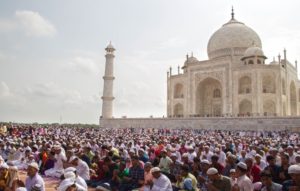 Modern Languages student Sophia Akbari tells us how Eid-al-fitr is celebrated in Islam
Modern Languages student Sophia Akbari tells us how Eid-al-fitr is celebrated in Islam
As the end of Ramadan draws closer, Muslims all over the world will celebrate Eid-al-Fitr, one of the religion’s main festivals.
Eid-al-Fitr translates to ‘the feast of breaking the fast’. The fast, during the time of Ramadan, represents one of the five pillars of Islam – Sawm. It is considered as an act of worship and an opportunity for Muslims to get closer to God. During this time Muslims are to reflect on their bad habits, encouraged to detach from worldly pleasures and learn the attributes of patience, self-improvement and compassion.
During the month of Ramadan, Muslims fast as it is the most valued month in the Islamic calendar (Hijri) believed to be when the Holy Quran was first revealed. Throughout the holy month, Muslims wake up early to eat a pre-dawn meal (suhoor) and break their fast at sunset with dates and water (iftar).
Traditionally, Eid-al-Fitr is celebrated for three days as an official holiday in all Muslim-majority countries. However, the number of days varies with each country. Eid-al-Fitr begins with the sighting of the crescent moon (a day after the new moon) thus Muslims have to wait until the evening before Eid to confirm its date.
To celebrate a month full of successful fasting and worship it is marked with congregational prayers, dawn prayers – also known as Fajr with family followed by large celebrations and feasts with families and friends. It is a common tradition to spend the day visiting relatives and neighbours. In some countries, like India, families visit graveyards to offer their respects to family members who have passed.
During Eid the most popular greeting is ‘Eid Mubarak’ (Blessed Eid) or ‘Eid sa’id’ (Happy Eid) however greetings depend on the country and language, for example in Turkey a common Eid greeting is ‘Multu Bayramlar’. It is a time filled with joy when many children receive gifts and money from family elders as a form of appreciation.
Eid-al-Fitr is sometimes known as ‘the Sugar Feast’ due to the number of desserts prepared for the special occasion. Muslims are urged to feast and celebrate the month of worship. In Yemen, ‘Bint Alsahan’ is a traditional dessert, a sweet made by folding thin layers of dough coated with honey and nigella seeds whereas in Egypt families indulge in ‘Kahk’, a cookie filled with a special honey filling.
Amid the festivities and joy, Eid-al-Fitr is also a time for charity thus it is important to donate (known as Zakt Al-Fitr) where food and money donations are collected and given to less wealthy.
However, this year’s celebrations will undeniably be a less festive time during the coronavirus pandemic as all countries must take precautions to limit the spread of the virus by closing mosques and restricting social gatherings. Festivities will be dampened by the economic hardship, illness and suffering which has occurred due to the virus. Although the absence of prayers in mosques and celebrations under the current restrictions will mark 2020 as a year of suffering, we should remain hopeful and celebrate virtually with our families as well as pray that an Eid like this one will never have to be repeated again.

Join the discussion
0 people are already talking about this, why not let us know what you think?